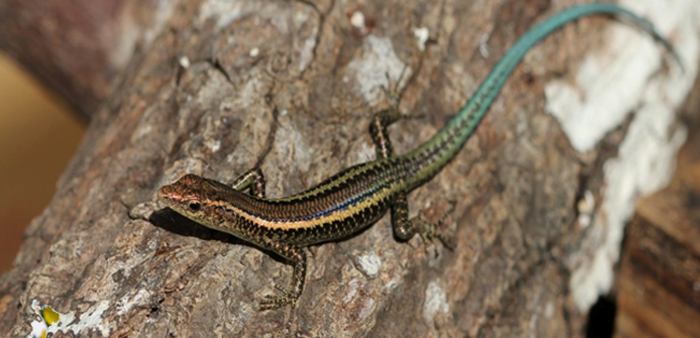
Christmas Island lizards are on their way back from the brink of extinction, but before they can roam free, more work needs to be done, says Emily Heber, a recent graduate from UC Santa Barbara with a BS in Zoology.
Christmas Island, located northwest of Australia in the Indian Ocean, is known globally for its biodiversity and striking native wildlife. The island is home to a variety of species found nowhere else in the world. Among these endemic species were four species of lizards that up until the 1970s had stable populations. Today, none of these lizards can be found in the wild and two of the island populations are presumed extinct.
Until the 1970s the blue-tailed skink (Cyptoblepharus egeriae), Christmas island forest Skink (Emoia nativitatis), Lister’s gecko (Lepidodactylus listeri), and coastal skink were found throughout the island. Records reveal that a dramatic decline took place on Christmas Island. Researchers point to the introduction of invasive predators such as invasive feral cats, giant centipedes, wolf snakes, and yellow crazy ants as the cause.
In 2009, Parks Australia collected as many lizards from the island as possible to begin a captive breeding program. The lizard collection showed promise for some species, but may have been too late for others. The rangers recovered 64 blue-tailed skinks, 43 Lister’s geckos, and three forest skinks. The three forest skinks were all females, the last of which died in 2014, and the species is now presumed to be extinct.
Researchers did not locate any coastal skinks, but the species survives on neighboring islands. Since then, populations in captivity have grown. Dr John Woinarski at Charles Darwin University in Australia commented:
“The captive population…continues to increase…The populations of blue-tailed skinks have recently passed 1000 individuals, and there are now over 900 Lister’s geckos.”
Increased captive breeding populations give hope for the future return of the species to Christmas Island, but before a release can take place it is crucial to confirm the key drivers in the lizards’ initial declines. By analyzing the pattern of lizard decline in relation to the presence of invasive species, researchers suspect that the invasive wolf snake is largely responsible. For the lizard species to return to the wild, the invasive species driving their declines must be removed. Only then can the lizards of Christmas Island thrive.
This story first appeared on the Island Conservation website, with whom we are working to accelerate action on invasive species to protect our precious island environments in Australia and the South West Pacific.
About the author
 Emily is a recent graduate from UC Santa Barbara with a BS in Zoology. As a student, she discovered that she had a passion for the conservation of endangered species and their ecosystems. Her background in informal education has allowed her the opportunity to share her passion for animals with others, something she seeks to continue doing while working with the communication team. She has been obsessed with the ocean ever since she was a little kid visiting the Monterey Bay Aquarium. In her spare time, Emily enjoys exploring the amazing hiking trails found in Santa Cruz and tries to SCUBA dive whenever possible. Emily is excited to join the Island Conservation team and to help share the amazing work that is being done here.
Emily is a recent graduate from UC Santa Barbara with a BS in Zoology. As a student, she discovered that she had a passion for the conservation of endangered species and their ecosystems. Her background in informal education has allowed her the opportunity to share her passion for animals with others, something she seeks to continue doing while working with the communication team. She has been obsessed with the ocean ever since she was a little kid visiting the Monterey Bay Aquarium. In her spare time, Emily enjoys exploring the amazing hiking trails found in Santa Cruz and tries to SCUBA dive whenever possible. Emily is excited to join the Island Conservation team and to help share the amazing work that is being done here.

